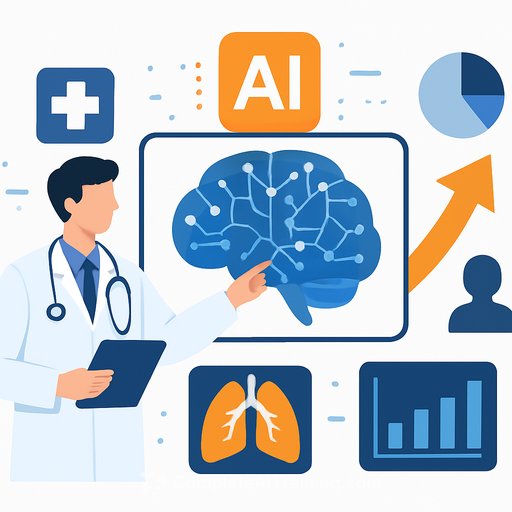AI in Medical Imaging: Market Outlook to 2032
The AI in medical imaging market is on track to grow from roughly USD 1.6 billion in 2024 to ~USD 13 billion by 2032, a CAGR of ~29% from 2025-2032. The momentum is driven by the rising burden of cancer, cardiovascular, and neurological diseases, paired with the need for faster, more accurate diagnostics and leaner workflows.
Healthcare systems are moving from pilots to scaled deployment as algorithms prove clinical value, regulators clear more solutions, and vendors tighten integration with existing imaging stacks.
Why this market is scaling
- Chronic disease pressure: Oncology, cardiology, and neurology require frequent, precise imaging. AI boosts detection of subtle findings, supports risk stratification, and speeds reads to cut delays in care.
- Product innovation: Vendors are investing in deep learning, computer vision, and workflow orchestration. Partnerships and acquisitions are accelerating feature depth and go-to-market reach.
- Policy and funding: Government programs that back digitization, early detection, and precision care are lowering adoption barriers through grants, incentives, and clearer regulatory pathways.
Market size and leaders
Deep machine learning held the largest technology share in 2024, reflecting its strong performance in detection, segmentation, and triage. North America accounted for ~42% of the market in 2024 and is expected to maintain the fastest growth due to high healthcare spending, mature infrastructure, and proactive regulatory activity.
Regional snapshot
North America: Strong vendor presence, active health systems, and an enabling regulatory framework-including frequent FDA 510(k) clearances-keep adoption high. Chronic disease prevalence and integrated academic-industry networks fuel real-world validation.
Europe: Steady growth anchored by advanced health systems and investment in digital health. Germany, the U.K., France, and Switzerland are scaling AI for early detection, workflow efficiency, and personalized care.
Asia-Pacific: Strong investment in imaging infrastructure and cloud AI across China, Japan, South Korea, and India. Rising rates of cancer, cardiovascular disease, diabetes, and neurological conditions are increasing demand for high-precision tools.
Recent moves to watch
- Aug 2025: RIVANNA received an $800,000 grant from the Virginia Catalyst Program to advance the Accuro 3S ultrasound system with academic partners.
- Aug 2025: Nerveblox (SmartAlpha) secured FDA 510(k) clearance for AI-assisted ultrasound-guided regional anesthesia; related AI-enabled cardiac imaging software also cleared earlier in April 2025.
- Feb 2025: RapidAI Lumina 3D obtained FDA 510(k) clearance for near-instant 3D reconstructions from CTA, supporting neuroradiology with vessel segmentation and bone removal.
What AI does in imaging
AI supports detection, classification, and quantification across X-ray, CT, MRI, and ultrasound. By automating repetitive tasks and triage, it reduces time to read, flags critical findings sooner, and gives radiologists space to handle complex cases and multidisciplinary decisions.
Segmentation at a glance
- Technology: Machine Learning, Deep Machine Learning, Natural Language Processing, Computer Vision
- Modality: X-ray, MRI, CT, Ultrasound, Others
- Offering: Hardware, Software, Services
- Applications: Oncology, Neurology, Cardiology, Orthopedics, Others
- End users: Hospitals and Clinics, Diagnostic Imaging Centers, Others
- Geography: North America, Europe, Asia-Pacific, Rest of World
Key players to track
- GE HealthCare; Siemens Healthcare Private Limited; Koninklijke Philips N.V.; Canon Medical Systems; Fujifilm Holdings Corporation; Hologic, Inc.; AGFA Healthcare
- Abbott; IBM Watson Health; Aidoc; Zebra Medical Vision; TEMPUS; Enlitic, Inc.; HeartFlow, Inc.; Lunit Inc.; RadNet, Inc.; Qure.ai; VUNO, Inc.; iRhythm Technologies; Royal Health Inc.
Practical playbook for healthcare teams
- Pick high-yield use cases: Focus on pathways with clear time or accuracy gains-stroke triage in CT, pulmonary embolism in CTA, mammography, chest X-ray triage, liver and prostate MRI.
- Integrate into the workflow: Require seamless PACS/RIS/EHR integration, automated worklist prioritization, and structured reporting that fits current reading patterns.
- Validate locally: Run a phased rollout with silent mode, then monitored live use. Track sensitivity/specificity, time savings, and impact on report addenda before scaling.
- Data quality and bias checks: Ensure representative datasets across scanners, sites, and demographics. Reassess performance after protocol or hardware changes.
- Regulatory and safety: Prefer FDA/CE-cleared products for the intended use. Maintain a change log and governance for version updates and post-market monitoring.
- Upskill the team: Short, role-based training for radiologists, technologists, and IT. Include failure modes and escalation paths.
- Procurement and ROI: Tie contracts to measurable KPIs-turnaround time, time-to-notification for critical findings, reduced variance, throughput, and reimbursement capture.
Risks and compliance checkpoints
- Clinical accountability: Clarify decision rights; AI supports, clinicians decide. Keep clear documentation in the report.
- Interoperability: Confirm DICOM/IHE profiles, cloud/on-prem options, and vendor support for multi-site, multi-vendor environments.
- Cybersecurity and privacy: Enforce PHI safeguards, access controls, and audit trails; assess vendor security posture annually.
- Real-world drift: Monitor model performance over time; revalidate after protocol shifts or major software updates.
Where AI adds immediate value
- Neuro: LVO/ICH detection and triage, perfusion maps, CTA reconstructions.
- Cardio/vascular: Coronary CTA analysis, calcium scoring, aortic dissection detection.
- Oncology: Nodule detection and risk, lesion segmentation, treatment response metrics.
- MSK and trauma: Fracture detection, spine measurements, ultrasound-guided procedures.
- Ops: Worklist prioritization, quality control, dose and protocol standardization.
Metrics that matter
- Report turnaround time and time-to-notification for critical findings
- Sensitivity/specificity vs. baseline, false-positive rate, addenda rates
- Throughput (studies per FTE), backlog reduction, after-hours coverage
- Length of stay impact for targeted pathways (e.g., stroke)
- Utilization, user adoption, and reimbursement capture where applicable
Outlook
Expect continued scale as deep learning systems mature, more modalities gain AI support, and reimbursement and regulatory clarity improve. Teams that select focused use cases, integrate tightly, and measure outcomes will see the clearest clinical and financial gains.
If you're building AI capability across clinical and operational roles, explore practical upskilling options here: AI courses by job and latest AI courses.
Your membership also unlocks:






